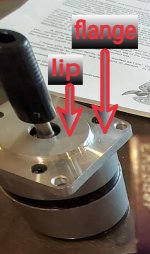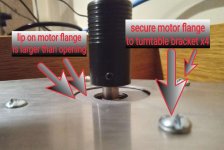I bought an 1/8" thick sheet, with the hopes of cutting a few gaskets for vibration control.
This stuff is nearly impossible to cut cleanly, or even cut at all. It takes several passes to even break through to the other side, and then I have to flip it and cut some more. It pulls, stretches, and eventually slices, but it's ugly. At least it's tacky enough to help hold a straight edge guide.
Any tips? I even tried a razor blade (a real one, made for double edge wet shaving).
This stuff is nearly impossible to cut cleanly, or even cut at all. It takes several passes to even break through to the other side, and then I have to flip it and cut some more. It pulls, stretches, and eventually slices, but it's ugly. At least it's tacky enough to help hold a straight edge guide.
Any tips? I even tried a razor blade (a real one, made for double edge wet shaving).
I have used an electric carving knife to cut mattress foam. I picked up one cheap at a Goodwill and then dropped it off after I was done.
I use a paper cutter to do clean cuts on such things.
Even sheet metal aluminum flashing.
It's only a one-time investment as a great tool to have if you're doing custom stuff.

Even sheet metal aluminum flashing.
It's only a one-time investment as a great tool to have if you're doing custom stuff.
Or several guided (with a straight edge like a ruler) passes with a cutter (the kind you can break the blades to get new corners every time).
Going deeper in the same cut with every pass till you go through.
Careful if you are not dextrous.

Also called a utility knife, it seems.
Do it on a non slip surface, ordinary non glossy newspaper works, and you will not damage your table top or whatever if the blade goes through.
If doing regularly, get what wise said above.
Going deeper in the same cut with every pass till you go through.
Careful if you are not dextrous.
Also called a utility knife, it seems.
Do it on a non slip surface, ordinary non glossy newspaper works, and you will not damage your table top or whatever if the blade goes through.
If doing regularly, get what wise said above.
You can form the gaskets in place with the right grade of silicon, many types in automotive use.
There are grades for head gaskets to under body lining, so choose one.
Even the bathroom grade, if non drying, should work.
No need to cut sheets.
Use a release agent if you want to dismantle things later.
It sticks in place otherwise.
Silicon spray, baking paper, waxed paper used as sticker backing, even a film of oil...they are all suitable.
There are grades for head gaskets to under body lining, so choose one.
Even the bathroom grade, if non drying, should work.
No need to cut sheets.
Use a release agent if you want to dismantle things later.
It sticks in place otherwise.
Silicon spray, baking paper, waxed paper used as sticker backing, even a film of oil...they are all suitable.
Ok, I just realized my question was ambiguous. I'm looking to make some vibration control on my turntable motor mount, not automotive.
The Sorbothane would ideally be a square with a hole cutout in the center. It is thicker than the circular lip. On the photo, the circular lip is just visible. So there would be Sorbothane between the top of the motor flange and the mount on the turntable. The circular lip would not be in contact with the turntable motor bracket.


The Sorbothane would ideally be a square with a hole cutout in the center. It is thicker than the circular lip. On the photo, the circular lip is just visible. So there would be Sorbothane between the top of the motor flange and the mount on the turntable. The circular lip would not be in contact with the turntable motor bracket.


What are you going to do for attachment? If you use screws, that will negate the presence of the Sorbothane because the vibration will couple right through the screws.
Good point. What do others do?What are you going to do for attachment? If you use screws, that will negate the presence of the Sorbothane because the vibration will couple right through the screws.
I'm looking to solve 2 issues:
1) the lip on the motor is larger than the opening in the turntable mount. The Sorbothane gasket would be thicker than the lip, so the lip doesn't need to fit through the hole.
2) vibration control. The motor is very silent, but I think the turntable mount acts like horn - amplifying the silent motor into audible sound.
Maybe I'm overthinking this, which I have a tendency to do.
You get tiny anti vibration mounts for instruments.
Look at their designs, you will have a better concept of what to do.
Then go ahead.
Look at their designs, you will have a better concept of what to do.
Then go ahead.
here is a product I've used successfully in the past, (you'll have to find the specific size you need):
https://www.amazon.com/Isolate-Sorbothane-Vibration-Isolation-Washer/dp/B0042UBWCE
https://www.amazon.com/Isolate-Sorbothane-Vibration-Isolation-Washer/dp/B0042UBWCE
The sensible thing would be to open up the mounting hole to clear the "lip" suffienciantly.Good point. What do others do?
I'm looking to solve 2 issues:
1) the lip on the motor is larger than the opening in the turntable mount. The Sorbothane gasket would be thicker than the lip, so the lip doesn't need to fit through the hole.
2) vibration control. The motor is very silent, but I think the turntable mount acts like horn - amplifying the silent motor into audible sound.
Maybe I'm overthinking this, which I have a tendency to do.
And as for the mounting screws, rubber grommets, or even better, the softer silicone ones added to the motor mounting holes, also widened for allow such a grommet. And/or remove the square flange mount and use the 3 screw holes with grommets/washers on the chassis.
That's the way isolation was done for decades and worked well.
- Home
- Design & Build
- Construction Tips
- Any advice on cutting sorbothane sheets?